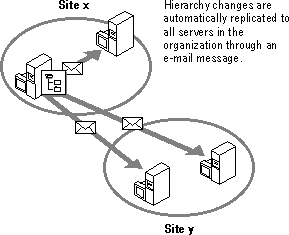
Each public folder server contains a replica of the hierarchy of all public folders in the organization. This information is read by Microsoft Outlook users and appears as a series of folders on the left side of the Microsoft Outlook window.
You cannot configure hierarchy replication as you can content replication. Hierarchy replication takes place automatically at an interval set in the registry. When a user logs on to a client, the client automatically reads the hierarchy from its public folder server.
When you create a top-level public folder, the folder, its hierarchy, and the folder contents are added to the Pub.edb file on your public folder server. The information is then sent as mail messages delivered by the MTA. After replication, users in the organization who are viewing information in the Pub.edb file for their public folder server see the new public folder in the hierarchy.
As shown in the following illustration, hierarchy changes are replicated to all servers in the organization.

From then on, when a user searches for information on the new public folder, the public information store on the local public folder server automatically directs the client computer to a public folder server that has the contents.
For more information on configuring hierarchy replication, see Microsoft Exchange Server Operations.